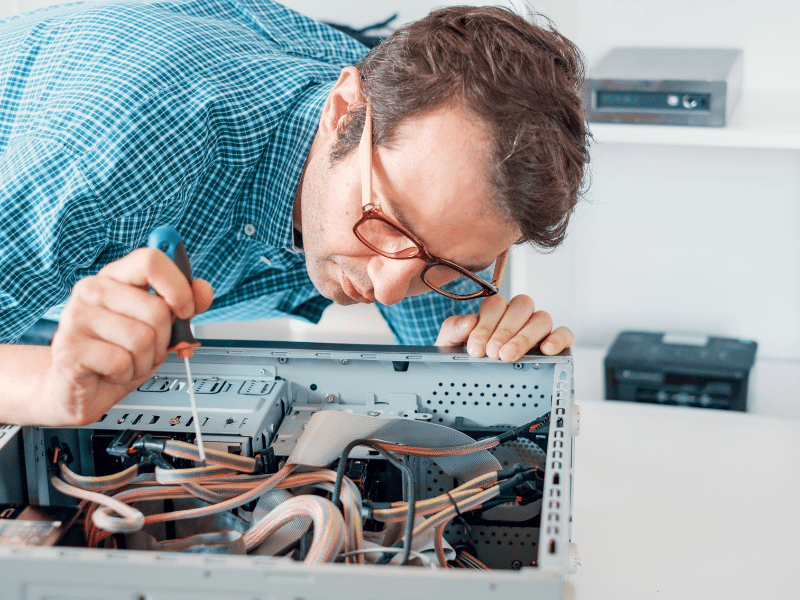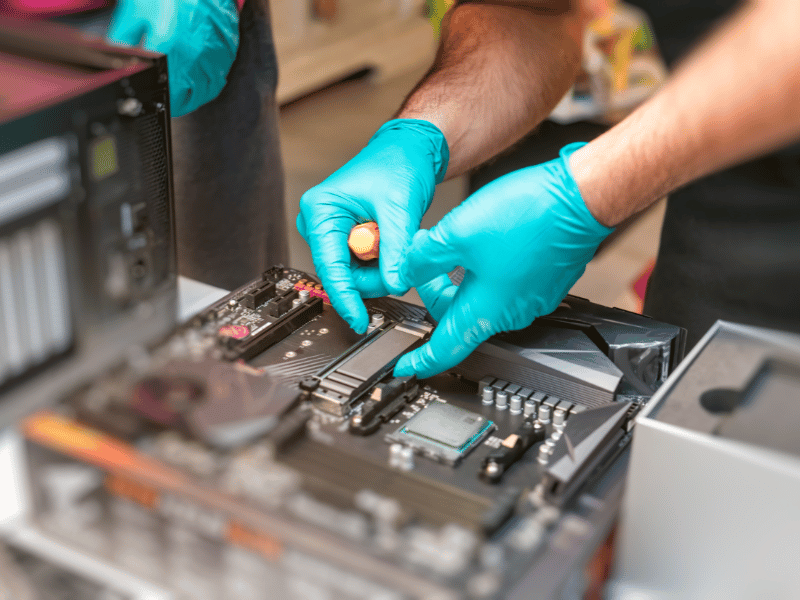Common Computer Issues: Slow Performance
Hey there, computer users! Ever felt that hair-pulling frustration when your trusty device decided to go all snail-paced on you? We get it—waiting for things to load, dealing with delays—it’s like a digital dance of patience that nobody signed up for.
But fear not! We’re here to talk about the need for a speedy intervention when your computer decides to take a leisurely stroll instead of a sprint. It’s not just about convenience; it’s about keeping your tech running in tip-top shape. Ignoring those sluggish signs might lead to bigger issues, and nobody wants that, especially when it comes to precious data.
In this guide, we’re going to explore the whys and hows of slow computer performance. More importantly, we’ll arm you with some user-friendly tips and tricks, so you can banish the slowness and reclaim your computer’s superhero speed. After all, a happy computer equals a happy you! Let’s jump into the solutions and make slow performance a thing of the past. 🚀
Understanding the Causes of Slow Performance
Alright, grab your detective hat, because we’re about to unravel the mystery behind your computer’s leisurely pace. It’s like a digital whodunit, and understanding the suspects is the first step to reclaiming your device’s speed. Let’s dive into the investigation:
Too Many Startup Programs:
A humorous and chaotic digital artwork of a laptop screen overflowing with dozens of colorful application icons and pop-up windows.
Ever noticed your computer doing the slow shuffle during startup? It might be playing host to a slew of unnecessary programs launching themselves into action. We’ll teach you how to cut through the startup clutter, giving your computer a VIP pass to a quicker launch.
Insufficient RAM:

A creative and metaphorical illustration showing a computer with human-like features, personifying the concept of RAM as short-term memory.
Think of your computer’s RAM as its short-term memory, which is essential for smooth operations. If it’s running low, your computer might be struggling to keep up. Don’t worry; we’ve got your back. We’ll guide you on how to check your RAM levels and ensure they’re flexing their memory muscles.
Running Out of Storage Space:

A metaphorical and imaginative digital illustration portraying a PC’s hard drive as a cluttered room.
Imagine your hard drive as a room; if it’s cluttered, finding what you need becomes a treasure hunt. We’ll take you on a digital cleaning spree, showing you how to sweep away those unnecessary files and create breathing space for your data.
Malware and Viruses:

An imaginative and allegorical digital artwork depicting malware and viruses as cartoonish, mischievous characters crashing a computer party.
Meet the uninvited guests crashing your computer’s party—malware and viruses. These troublemakers can turn your system into a slow-motion nightmare. Fear not! We’ll help you kick them out, strengthen your digital defenses, and restore order to the digital realm.
Fragmented Hard Drive:

An allegorical scene depicting a computer hard drive as a traditional wooden bookshelf in an old library.
Picture your hard drive as a bookshelf. When books are scattered all over the place, finding the right one becomes a hassle. We’re here to guide you in organizing that digital shelf, tidying up the fragments, and giving your computer a streamlined search process.
So, buckle up for this thrilling journey into the heart of your computer’s slowdown. Stick with us, and we’ll have your device cruising on the speedway of efficiency in no time. 🚗💨
Step-by-Step Troubleshooting Guide
Awesome! Now that we’ve uncovered the suspects responsible for your computer’s sluggish performance, it’s time to play hero. Buckle up for our step-by-step guide designed to unravel the mystery and restore your computer to its speedy glory. Let’s dive in:
Step 1: Check Startup Programs
Picture this: you power up your computer in the morning, ready to tackle the day, but it seems to be sipping its digital coffee at a leisurely pace. What’s the holdup? Well, there’s a good chance it’s hosting a morning parade of unnecessary programs, each vying for attention and slowing down the grand entrance.
Fear not! We’re here to be your computer’s personal trainer, guiding you through the process of trimming the startup fat. Here’s how to make your computer’s morning routine as brisk as a well-caffeinated kick:
Access the Task Manager:
– Press the magic combination: `Ctrl + Shift + Esc` to open the Task Manager. It’s like peering into the backstage chaos of your computer.
Navigate to the “Startup” tab:
– In the Task Manager, head to the “Startup” tab. This is where the magic (or sluggishness) happens.
Identify and disable unnecessary Programs:
– Take a look at the list of programs that launch at startup. Some are essential, but others are just freeloaders. Identify the unnecessary ones and disable them by right-clicking and selecting “Disable.”
Restart Your Computer:
– Once you’ve freed your computer from the unnecessary entourage, restart it. This gives your system a fresh start without the excess baggage.
Voila! Your computer should now be greeting you in the morning with the speed and enthusiasm of a well-caffeinated individual, ready to take on the day. Say goodbye to the slow morning crawl and hello to a swift and energetic startup! 🚀☕
Step 2: Assess RAM Usage
Alright, let’s dive into the brain of your computer—the RAM. Think of it as short-term memory, juggling tasks and information to keep things running smoothly. If your computer seems to be dragging its digital feet, it might be time to give its brain a bit of a workout. Don’t worry, we’re here to guide you through the process of checking your RAM usage and optimizing it for peak performance:
Open the Task Manager:
– Just like before, summon the task manager by pressing `Ctrl + Shift + Esc`. This is your backstage pass to your computer’s brain activity.
Navigate to the “Performance” tab:
– In the Task Manager, head over to the “Performance” tab. Here, you’ll find a wealth of information about your computer’s inner workings.
Check the “Memory” section:
– Look for the “Memory” section. This will show you how much RAM is currently in use. If it’s nearing full capacity, that could be the reason for the sluggishness.
Identify Memory-Hungry apps:
– Scroll down to see a list of running processes and the amount of memory they’re consuming. Identify any memory-hungry apps that might be hogging resources.
Close unnecessary Apps:
– If you spot any memory-hogging culprits that you’re not actively using, consider closing them. Right-click on the app and choose “End Task.”
Consider upgrading your RAM:
– If you find your RAM consistently reaching its limits, it might be worth considering a RAM upgrade for your computer. This can provide a significant boost in performance.
Just like a good workout for your computer’s brain, optimizing your RAM can bring back that snappy responsiveness. With these steps, you’ll ensure your computer’s memory is in tip-top shape, ready to tackle tasks with the agility of a well-trained athlete! 🏋️♂️💻
Step 3: Free Up Storage Space

A metaphorical illustration of freeing up storage space on a hard drive, depicted as decluttering a room.
Now, let’s talk about the digital equivalent of decluttering your room—freeing up storage space on your hard drive. An overflowing hard drive is like navigating a maze in the dark – it slows you down, and finding what you need becomes a Herculean task. Let’s embark on a digital cleaning escapade together, clearing the digital dust and creating ample space for your computer to stretch its virtual legs:
Check Your Disk Space:
– Open File Explorer and right-click on the drive where your operating system is installed (usually C:). Select “Properties” to see how much space is used and how much is free.
Delete unnecessary files:
– Navigate to your Downloads, Documents, and Desktop folders. Delete any files you no longer need. Remember, a tidy digital space is a happy digital space.
Clear temporary files:
– Run the built-in disk cleanup tool. Search for “Disk Cleanup” in the Start menu, select your drive, and let it scan. Check the boxes for temporary files and other unnecessary items before clicking “OK.”
Uninstall unnecessary programs:
– Go to the Control Panel, then “Programs” and “Programs and Features.” Uninstall any programs you no longer use. This not only frees up space but can also improve overall system performance.
Consider External Storage:
– If you have large files like videos or photos that you want to keep but don’t need daily access to, consider moving them to an external storage device. This clears up space on your computer while keeping your files accessible.
Disk Cleanup Utility (Windows):
– Use the built-in Disk Cleanup utility in Windows. Search for “Disk Cleanup” in the Start menu, select your drive, and let the utility calculate how much space you can free up. Review the suggested files and proceed with the cleanup.
By the end of this digital cleaning session, your computer’s hard drive will be breathing a sigh of relief, and you’ll notice a spring in its virtual step. Clearing out the clutter not only frees up space but also ensures your computer operates with the agility of a well-organized workspace. Happy cleaning! 🧹💻
Step 4: Scan for Malware and Viruses
Now, let’s tackle the party crashers – malware and viruses. These troublemakers are like uninvited guests wreaking havoc in your computer’s cozy digital home. If your computer is feeling under the weather, it might be time to show these intruders the virtual door. Here’s how to run a top-notch antivirus scan and restore your computer’s health:
Update Your Antivirus Software:
– Make sure your antivirus software is up to date. New threats emerge regularly, and having the latest definitions ensures your software can catch them.
Perform a full system Scan:
– Open your antivirus software and initiate a full system scan. This comprehensive scan will scrutinize every nook and cranny of your computer for potential threats.
Quarantine or Remove Detected Threats:
– If the scan detects any malware or viruses, follow the prompts to quarantine or remove them. This is like kicking those unwanted party crashers out of your computer’s space.
Run a Malwarebytes Scan (Optional):
– For an extra layer of security, consider running a scan with Malwarebytes. This tool can catch some threats that traditional antivirus software might miss.
Be cautious online:
– Prevention is key. Be cautious when clicking on links or downloading files, especially from unknown sources. Practice safe browsing habits to minimize the risk of future infections.
By the end of this malware-busting mission, your computer will be grateful for the eviction of these digital troublemakers. Running regular antivirus scans is like giving your computer a wellness check, ensuring it operates smoothly and securely. Ready to give those party crashers the boot? Let’s get scanning! 🦠🚫💻
Step 5: Defragment the Hard Drive

A metaphorical illustration of the process of defragmentation on a computer hard drive, visualized as organizing a messy bookshelf.
Alright, time to tidy up the digital bookshelf. Let’s talk about defragmentation. Just like a messy bookshelf makes finding your favorite novel a challenge, a fragmented hard drive slows down your computer’s search for data. Let’s dive into the art of defragmentation, putting your digital books back in order, and ensuring your computer can find what it needs without breaking a sweat:
Understand Fragmentation:
– Think of your hard drive as a library of digital books. Over time, these books (or files) can get scattered all over the shelves, making it harder for your computer to find them quickly. This is fragmentation.
Use the Built-In Windows defragmenter:
– Windows comes with a built-in defragmentation tool. Search for “Defragment and Optimize Drives” in the Start menu, select your drive, and click “Optimize.” This tool rearranges the digital books, making them easier to access.
Schedule regular defragmentation:
– Set up a schedule for regular defragmentation. Windows can do this automatically. In the “Optimize Drives” window, click on “Change settings,” check the box for “Run on a schedule,” and choose a frequency.
Be patient during the Process:
– Defragmentation takes time, especially if it’s the first time or if it’s been a while. Let the tool do its work, and you’ll notice improved performance afterward.
Consider Third-Party Defragmentation Tools (Optional):
– If you want more control or additional features, consider third-party defragmentation tools like Defraggler or Auslogics Disk Defrag.
By the end of this defragmentation session, your computer’s digital library will be neatly organized, and finding files will be a breeze. It’s like giving your computer a librarian who knows exactly where every digital book is stored. Are you ready to let the defragmentation magic begin? Let’s get those digital books back in order! 📚✨💻
How Safemode Computer Service Can Help
Congratulations on successfully navigating through our troubleshooting guide! If you ever find yourself facing challenges beyond DIY fixes or if you simply prefer the expertise of professionals, Safemode Computer Service is here to lend a helping hand.
- Comprehensive Diagnostics:
Safemode Computer Service offers thorough diagnostics to identify the root cause of your computer’s issues. Their experienced technicians use advanced tools to pinpoint problems that may be challenging to identify on your own.
- Expert Repair and Optimization:
Once the issue is identified, Safemode Computer Service provides expert repair and optimization services. Whether it’s replacing faulty hardware components, fine-tuning system settings, or upgrading your system for better performance, they’ve got you covered.
- Malware and virus removal:
If malware or viruses are causing havoc on your computer, Safemode Computer Service employs state-of-the-art security measures to eliminate these threats and restore your system to a secure state.
- Hardware Upgrades:
Thinking about boosting your computer’s capabilities with hardware upgrades? Safemode Computer Service can recommend and install upgrades such as additional RAM, faster storage solutions, or enhanced graphics cards to meet your specific needs.
- Data Recovery:
In the unfortunate event of data loss, Safemode Computer Service provides data recovery services. Whether it’s due to hardware failure or accidental deletion, their experts can help retrieve your valuable files.
- Ongoing Maintenance Plans:
Prevention is key to avoiding future issues. Safemode Computer Service offers ongoing maintenance plans to keep your computer in top-notch condition. Regular check-ups, software updates, and security patches ensure a smooth and trouble-free computing experience.
Remember, your computer’s health is in good hands with Safemode Computer Service. Feel free to reach out whenever you need professional assistance, and let them take the stress out of computer repair and maintenance. Your tech happiness is their priority! 🛠️💻🔧
Prevention Tips
Now that you’ve tackled the current issues and know where to turn for professional help, let’s talk about keeping your computer in tip-top shape. Here are some prevention tips to ensure you have a smooth and trouble-free computing experience:
- Regular Software Updates:
– Keep your operating system, antivirus software, and other essential programs up to date. Software updates often include security patches and performance enhancements.
- Mindful Internet Browsing:
– Be cautious about the websites you visit and the files you download. Avoid clicking on suspicious links or downloading files from unknown sources to minimize the risk of malware and viruses.
- Backup your data:
– Regularly back up your important files to an external drive or cloud storage. This ensures that even if the unexpected happens, your valuable data remains safe and can be easily recovered.
- Stay Organized:
– Maintain a clutter-free digital space. Regularly clean up unnecessary files, organize your folders, and uninstall programs you no longer need to keep your computer running smoothly.
- Invest in quality hardware:
– When upgrading or purchasing new hardware, invest in quality components. This can contribute to better overall performance and longevity for your computer.
- Be mindful of startup programs:
– Periodically review and manage the programs that launch at startup. This helps prevent unnecessary strain on your computer’s resources, ensuring a faster and more efficient startup process.
- Use a surge Protector:
– Protect your computer from electrical surges by using a reliable surge protector. Sudden power fluctuations can damage hardware components, so it’s better to be safe than sorry.
By incorporating these prevention tips into your routine, you’ll not only maintain your computer’s current health but also prevent future issues from arising. Remember, a little proactive care goes a long way in ensuring a hassle-free computing experience. Happy computing! 🌐💻🔒
When to Seek Professional Help

A metaphorical illustration representing the concept of seeking professional assistance for computer issues.
While the troubleshooting steps and prevention tips provided here can address many common computer issues, there are times when professional assistance becomes essential. Recognizing when to seek expert help can save you time, prevent further complications, and ensure the longevity of your computer.
Here are signs that it’s time to reach out to professionals like Safemode Computer Service:
- Persistent Issues:
– If you’ve attempted the troubleshooting steps but the problem persists or reoccurs, it’s a clear indicator that there might be a deeper issue. Professional technicians can conduct in-depth diagnostics to identify and resolve complex issues.
- Unusual Noises or Hardware Failures:
– Strange noises emanating from your computer, sudden hardware failures, or unexplained crashes could indicate a hardware problem. Professional technicians have the expertise to diagnose and address hardware issues effectively.
- Data loss or corruption:
– If you experience data loss or corruption and are unable to recover your valuable files, seeking professional help is crucial. Safemode Computer Service offers data recovery services to retrieve lost data due to various reasons.
- Need for hardware upgrades:
– When considering hardware upgrades for improved performance or additional capabilities, professional advice can ensure compatibility and optimal installation.
- System Optimization and Maintenance:
– Professional services like Safemode Computer Service offer comprehensive system optimization and maintenance plans. Regular check-ups and tune-ups performed by experts can keep your computer running smoothly.
- Security Concerns
– If you suspect or detect security threats, malware, or viruses on your computer, seeking professional help ensures a thorough removal process and safeguards your system against future threats.
Remember, Safemode Computer Service is just a call away when you encounter challenges that go beyond DIY solutions. Their team of experienced technicians is ready to provide the expertise needed to keep your computer in prime condition. Don’t hesitate to reach out when your computer needs the care of professionals! 🛠️💻👨💻
Conclusion
Congratulations on navigating through our comprehensive guide to troubleshooting and maintaining your computer’s performance! We’ve covered everything from identifying the causes of slow performance to preventive measures and when to seek professional help. By following these steps, you’ve taken a proactive approach to ensuring your computer runs smoothly and efficiently.
Remember, your computer is a powerful tool, but like any tool, it requires regular care and attention. Whether you’ve successfully resolved an issue on your own or decided to enlist the help of Safemode Computer Service, you’ve empowered yourself to make the most of your technology.
As you continue your computing journey, stay mindful of preventive measures, keep your system updated, and be attentive to any changes in performance. Regular maintenance is the key to a hassle-free and enjoyable computing experience.
If you ever find yourself facing new challenges or simply want to optimize your computer’s performance, don’t hesitate to reach out to Safemode Computer Service. Their team of professionals is dedicated to ensuring your technology works seamlessly, allowing you to focus on what matters most.
Thank you for joining us on this journey to computer wellness. Here’s to a future of fast, reliable, and stress-free computing! 🚀💻🔧
Computer Repair and Services
Free estimate. Same-day services – Safemode Computer Service











